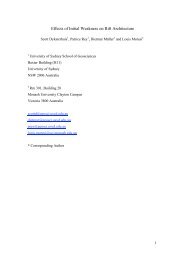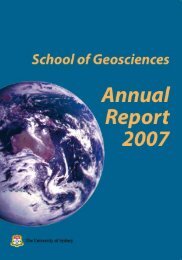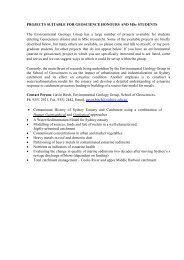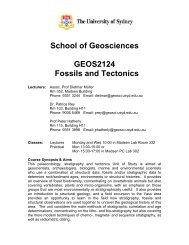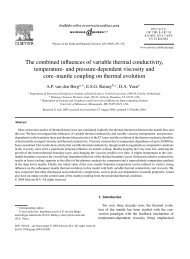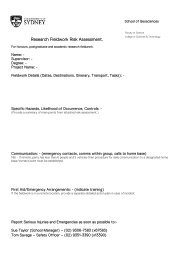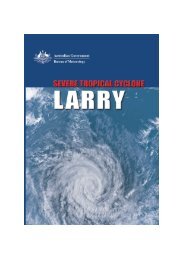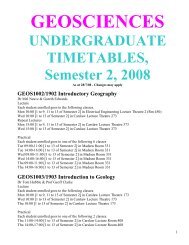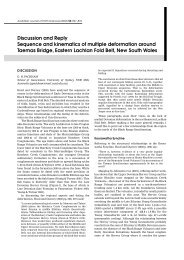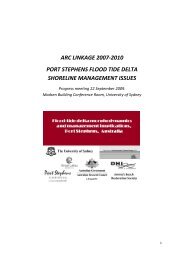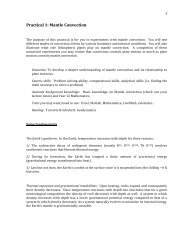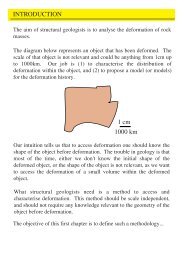Geological and historical records of tsunami in Australia
Geological and historical records of tsunami in Australia
Geological and historical records of tsunami in Australia
You also want an ePaper? Increase the reach of your titles
YUMPU automatically turns print PDFs into web optimized ePapers that Google loves.
102 D. Dom<strong>in</strong>ey-Howes / Mar<strong>in</strong>e Geology 239 (2007) 99–123<br />
<strong>in</strong>tensity (TI) score is given to each event permitt<strong>in</strong>g<br />
direct comparison with other events <strong>in</strong> the Austro–Asia,<br />
Asia–Pacific region (e.g., 1998 Papua New Gu<strong>in</strong>ea<br />
<strong>tsunami</strong>). A TI value is provided rather than the more<br />
common ‘run-up’ because run-ups on the <strong>Australia</strong>n<br />
coast are difficult to determ<strong>in</strong>e where there have been no<br />
post-event surveys or eye witness observations. Also,<br />
detail exists with<strong>in</strong> the documentary accounts that may<br />
be used to broadly determ<strong>in</strong>e <strong>in</strong>tensity.<br />
3. Results<br />
The results are presented <strong>in</strong> dist<strong>in</strong>ct subsections. First,<br />
the full list <strong>of</strong> <strong>tsunami</strong> identified <strong>in</strong> this study is presented<br />
<strong>and</strong> particular details <strong>of</strong> general <strong>in</strong>terest are noted. Next,<br />
detail concern<strong>in</strong>g the palaeo <strong>and</strong> historic <strong>tsunami</strong> <strong>records</strong><br />
respectively, are provided. These events have been separated<br />
out <strong>in</strong> order to provide a more realistic underst<strong>and</strong><strong>in</strong>g<br />
<strong>of</strong> hazard s<strong>in</strong>ce it will be seen that the palaeo<br />
record is dom<strong>in</strong>ated by a trend <strong>of</strong> low-frequency highmagnitude<br />
events <strong>and</strong> the historic record is characterised<br />
by the reverse. Lastly, the geological record <strong>and</strong> geomorphological<br />
effects <strong>of</strong> <strong>tsunami</strong> on the natural environment<br />
are described <strong>and</strong> their characteristics noted.<br />
3.1. The catalogue <strong>of</strong> <strong>Australia</strong>n <strong>tsunami</strong><br />
There are 57 <strong>in</strong>dividual <strong>tsunami</strong> identified with<strong>in</strong> this<br />
study. Table 1 provides a quick look summary <strong>of</strong> the<br />
events. The full catalogue is presented <strong>in</strong> Appendix A.<br />
The date <strong>of</strong> the oldest event is 3.47 Ga years before<br />
present. The most recent event is dated the 17th July<br />
2006. <strong>Australia</strong> preserves a geological record <strong>of</strong> <strong>tsunami</strong><br />
that stretches back over 3.5 billion years. Two billion<br />
years separate the two oldest events <strong>in</strong> the catalogue from<br />
the next event. The palaeo<strong>tsunami</strong> record is comprised <strong>of</strong><br />
ten events <strong>and</strong> 47 events make up the historic record.<br />
The catalogue conta<strong>in</strong>s <strong>in</strong>terest<strong>in</strong>g data regard<strong>in</strong>g the<br />
number <strong>of</strong> events recorded by state. New South Wales<br />
(NSW) <strong>records</strong> 44 events (77% <strong>of</strong> all events); the<br />
Northern Territory (NT) <strong>records</strong> none (0); Queensl<strong>and</strong><br />
(QLD) <strong>records</strong> n<strong>in</strong>e events; South <strong>Australia</strong> (SA) <strong>records</strong><br />
five events; Tasmania (TAS) <strong>records</strong> ten events; Victoria<br />
(VIC) <strong>records</strong> five <strong>and</strong> Western <strong>Australia</strong> (WA) <strong>records</strong><br />
twelve events (Fig. 2a). It should be noted that the total<br />
number <strong>of</strong> events recorded by all states is greater than the<br />
total number <strong>of</strong> events with<strong>in</strong> the catalogue because an<br />
<strong>in</strong>dividual <strong>tsunami</strong> may have <strong>in</strong>undated the coast <strong>of</strong> more<br />
than one state. NW Western <strong>Australia</strong> <strong>records</strong> a<br />
significant number <strong>of</strong> <strong>tsunami</strong> observations — twelve<br />
out <strong>of</strong> 57 (or 21%). Thirty-five events (or 61.4%) were<br />
generated as a consequence <strong>of</strong> earthquake; two events (or<br />
3.5%) were caused by volcanic eruptions; three events<br />
(or 5.3%) were generated by asteroid impact; one event<br />
(or 1.75%) was generated by a submar<strong>in</strong>e l<strong>and</strong>slide <strong>and</strong><br />
significantly, sixteen events (or 28.1%) were generated<br />
by unknown causes.<br />
3.1.1. The <strong>Australia</strong>n palaeo<strong>tsunami</strong> record<br />
The Quick Look Table (Table 1) <strong>and</strong> Appendix A<br />
<strong>in</strong>dicate that geological evidence for ten <strong>tsunami</strong> have<br />
been identified for the period prior to European<br />
occupation <strong>of</strong> <strong>Australia</strong>. In this study, the ‘palaeo’<br />
record is that which occurred prior to European<br />
occupation although it is recognised that <strong>Australia</strong> has<br />
been occupied by <strong>in</strong>digenous people for more than<br />
40,000 years (O'Connell <strong>and</strong> Allen, 2004). These ten<br />
events represent 17.5% <strong>of</strong> the total number <strong>of</strong> events<br />
reported with<strong>in</strong> the catalogue. The two oldest events are<br />
dated 3.47 Ga <strong>and</strong> 2.47–2.6 Ga respectively. Approximately<br />
1.9 billion years separate these two from the<br />
next. No geological evidence has been reported for<br />
palaeo<strong>tsunami</strong> between the third event at 570 Ma <strong>and</strong><br />
the fourth event at 105 ka. This <strong>in</strong>dicates that a<br />
significant hiatus exists with<strong>in</strong> the palaeo<strong>tsunami</strong><br />
record. Another significant break exists between the<br />
fourth event dated at 105 ka <strong>and</strong> the rema<strong>in</strong><strong>in</strong>g six<br />
events which all occurred with<strong>in</strong> the Holocene period.<br />
The three oldest <strong>tsunami</strong> events reported were<br />
triggered by asteroid impact <strong>and</strong> generated dist<strong>in</strong>ctive<br />
<strong>tsunami</strong> deposited sediments that have become components<br />
<strong>of</strong> the <strong>Australia</strong>n geological record. The reason that<br />
these events are <strong>in</strong>cluded is to illustrate that <strong>tsunami</strong> have<br />
impacted <strong>Australia</strong> for a very long time. The fourth event<br />
dated at 105 ka is thought to have been generated by<br />
submar<strong>in</strong>e sediment slides <strong>of</strong>f Lanai, Hawai'i (Young et<br />
al., 1992, 1993, 1996). The causes <strong>of</strong> the other six events<br />
are unknown.<br />
The maximum run-up for a palaeo<strong>tsunami</strong> is +100 m<br />
above sea level (m asl) — possibly as much as +130 m<br />
asl (event ID number 5 <strong>in</strong> Appendix A) which is<br />
recorded at Steamers Beach, Jervis Bay, New South<br />
Wales (see Fig. 3 for location). This event occurred at<br />
circa 8700–9000 BP. It is not known what process<br />
generated this <strong>tsunami</strong>, nor where it came from. A<br />
<strong>tsunami</strong> that is reported to have occurred at circa<br />
6500 BP may have <strong>in</strong>undated to a distance <strong>of</strong> 10 km<br />
<strong>in</strong>l<strong>and</strong> across the Shoalhaven delta area <strong>of</strong> New South<br />
Wales. Aga<strong>in</strong>, no <strong>in</strong>formation is available about the<br />
cause or orig<strong>in</strong> location <strong>of</strong> this event.<br />
Fig. 2b shows the distribution <strong>of</strong> palaeo<strong>tsunami</strong> by<br />
state <strong>and</strong> New South Wales (NSW) preserves evidence<br />
for seven (or 70%) <strong>of</strong> all reported palaeo<strong>tsunami</strong><br />
events.



